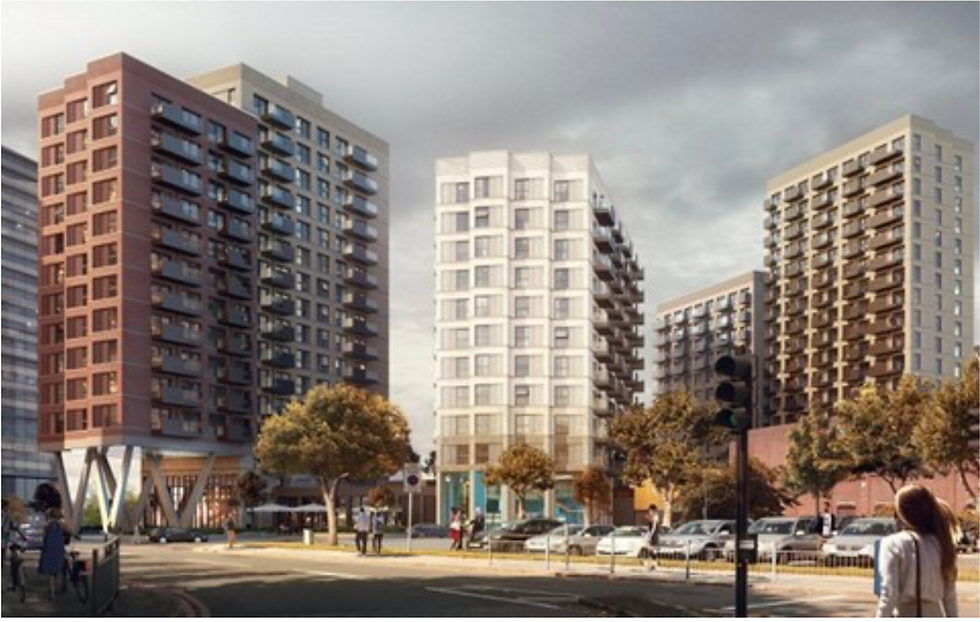Citroen Site Public Inquiry
- Lucy Jarvis
- Oct 14, 2020
- 5 min read
By Chris Griffiths, LLB (Hons) MA IHBC

A short article on the outcome of a major application in Brentford (Hounslow LBC) supported by the Mayor of London and determined by the Secretary of State in September 2020.
The outcome of a public inquiry I recently gave evidence to on behalf of the Mayor of London was published on 10th September (see link below). The approved scheme is a major development at the Citroen Site near Kew Bridge, Brentford, for 441 residential units, 50% of which are affordable, distributed throughout 3 linear tower blocks of 16, 17 and 18 storeys.
The background to the case is rather complex but essentially the Mayor of London took over the application in February 2018 having been advised by the London Borough of Hounslow that it was minded to refuse permission for the redevelopment. The scheme was subsequently amended to achieve a higher proportion of affordable housing, with a slight increase in the height to one of the towers. The Mayor resolved to grant planning permission in August 2018. The application was then called in by the Secretary of State to be determined at public inquiry. Heritage Collective, part of HCUK Group, was appointed by the Mayor of London to provide independent advice on heritage matters and to give evidence at the inquiry which took place in January 2020.
The main bone of contention was the impact on heritage assets, including many highly graded and one in the highest category of significance (Royal Botanic Gardens Kew, World Heritage Site). The surrounding area is subject to a raft of other designations and an important architectural frontage to the Thames at Strand on the Green is situated to the south east. The latter is a conservation area and includes a fine sequence of listed buildings, including Zoffany House (Grade II*). The river frontage and Kew Gardens together form part of a riverine landscape of outstanding heritage and cultural value, unique in the UK. The preservation of its significance has been the subject of much debate in recent years prompted by a series of development proposals to the north of the river within the Great West Corridor opportunity area. The most well-known recent case is that of the Chiswick Curve which was called in for determination by the Secretary of State in 2018. That inquiry resulted in the scheme being recommended for approval by the Planning Inspector, but this was rejected by the Secretary of State and planning permission refused.
The Chiswick Curve scheme, at 32 storeys, was significantly taller than the Citroen Site proposal, resulting in a much wider impact on the surrounding area, notably Kew Gardens, as well as the highly valued river frontage. By contrast, the impact of the Citroen scheme considered at the inquiry was distilled down to four key views and two in particular. The impact on the World Heritage Site hinged on the effect the development would have on the setting of the Grade I listed Orangery, a magnificent garden building designed by William Chambers in 1761, when viewed across the Great Lawn. The Inspector found that the level of harm was less than substantial but moderate within that category, and a similar level of harm to the world Heritage Site. I attributed a low level of harm to the relevant heritage assets in my evidence. The harm identified by the objecting parties was found by the Inspector to have been exaggerated. Much time in cross examination was given to thecalibration of cumulative harm as this had a particular relevance to the case in hand.
The Inspector’s deliberations on this point are instructive (paragraph 15.29) but essentially he concurred with the Mayor’s assessment that the harm resulting from the development did not compound the existing harm to the extent that it was driven upwards into a higher category of less than substantial, or even beyond that. The Inspector concluded that it was ‘a little, but not much, more than moderate’. The parallelsdrawn with the Westferry Printworks decision (now quashed) were considered to be unfounded, rightly in my view.
A similar line of argument followed in respect to Strand on the Green, though in that instance there was more consensus around the level of harm, being medium on the scale of less than substantial (Historic England considered this to be high less than substantial having previously cited substantial harm). The cumulative harm again fell well short of a ‘tipping point’ and did not come close of substantial. The Secretary of State agreed with this assessment and accepted the Inspector’s recommendation to grant planning permission subject to conditions etc.
The experience of the public inquiry was most absorbing. From a heritage point of view the development presented a plethora of issues on the subject of setting, as complex as any I have had to navigate in the past. Each heritage witness guided the inspector towards their particular conclusion about the effects on a diverse array of interrelated heritage assets followed by cross examination. Besides cumulative harm, there was plenty of discussion on the construction of London Plan Policy and the meaning of the words ‘conserve’ and ‘sustain significance’ as distinct from ‘preserve’ which is usually taken to mean the absence of harm. If my 20 years as a conservation professional have taught me anything it is that significance can indeed be sustained whilst tolerating some harm, provided the heritage asset in question has the capacity to accommodate it. Kew Gardens certainly has that capacity and my interpretation of the LP Policy was, shall we say, more nuanced than binary. The position taken by the Mayor of London is set out in paragraphs 7.43 – 7.48 of the decision. Ultimately, the Inspector did identify conflict with relevant policies 7.8 and 7.10 and explained that they do not have the same balancing exercise as paragraph 196 of the NPPF.
This suggests that a balancing exercise of sorts is nonetheless embedded within the wording of the policy.
In undertaking the Heritage Balance under NPPF paragraph 196 the inspector found that this should weigh in favour of the proposals and, as such, was an important material consideration. Thus, in spite of conflict with London Plan heritage policies at least, the Inspector considered the benefits of the scheme rendered the proposal in accordance with the development plan as a whole. Furthermore, the Inspector found that the favourable balance of the scheme because of the public benefits it would secure amounted to a material consideration of sufficient weight to indicate determination other than in accordance with the development plan. This underscored the point that conflict with London Plan heritage policies (and others) should not result in a different outcome from the NPPF and, in the circumstances of this case, conflict with the development plan as a whole should not prevent the granting of planning permission. The Secretary of State agreed (cf. decision letter paragraph. 32).
.png)



Comments